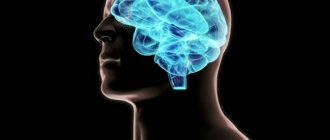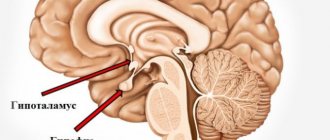Updated: 06/22/2021 The intense rhythm of life, stressful situations, increased physical or mental stress that we encounter almost every day ultimately lead to unstable functioning of the nervous system, which causes chronic fatigue, sleep disturbances, irritability, and memory loss. and other not very pleasant symptoms. Specially developed medications will help cope with these problems and even prevent their occurrence.
Of course, you can start leading an active lifestyle, eliminate bad habits, and balance your diet, but the human body cannot produce some substances for the stable functioning of the nervous system on its own. In this case, you simply cannot do without taking dietary supplements and vitamins.
Let's consider the main components of industrially produced drugs to normalize the functioning of the central nervous system. B vitamins are involved in many reactions necessary for the normal functioning of nerve cells.
- Vitamin B1.
It is not synthesized in the body, the only source is the food we eat. The substance is necessary for converting energy from food into energy substrates for cells. This vitamin is closely related to magnesium metabolism; deficiency leads to the death of neurons in the part of the brain that is responsible for memory function. - Vitamin B3.
Helps release energy from carbohydrates. With its deficiency, symptoms such as insomnia, stress, anxiety, depression, and muscle weakness appear. - Vitamin B4.
Stabilizes the functioning of the nervous system, stabilizes the restoration of nerve cells, stimulates the heart and improves blood supply to the brain. - Vitamin B5.
Plays an important role in the production of energy from fats and carbohydrates. A deficiency of the substance can lead to serious consequences for human health: memory, energy and resistance to stress decrease, and irritability appears. - Vitamin B6.
Necessary for the production of serotonin (“the hormone of happiness”) and maintaining stable functioning of the central nervous system. Deficiency can lead to a risk of Alzheimer's disease. - Vitamin B9 (folic acid).
Participates in the process of cell division and promotes fiber growth. The lack of this element leads to memory impairment. - Vitamin B12.
Has a positive effect on brain function and improves mood. - Vitamin C.
Not produced in the body. With its deficiency, memory and mental abilities decrease. - Vitamin D.
When it is deficient, symptoms of stress such as irritability and nervousness appear. The human body is able to independently synthesize this substance only with a sufficient amount of sunlight. - Vitamin E.
Helps relieve fatigue and irritation, has a calming effect.
In addition to vitamins, products for stabilizing the functioning of the nervous system contain micronutrients, minerals and auxiliary substances.
We present the rating of vitamins for the nervous system 2021. The best 12 products that were selected by our experts based on user reviews and ratings.
There are contraindications, be sure to consult your doctor!
| Rating (2021) | Prices, ₽ | A country |
| 1. Solgar magnesium citrate | from 900₽ | USA |
| 2. Doppelhertz Active Antistress | from 380₽ | Germany |
| 3. Orthomol Vital m | from 5000₽ | Germany |
| 4. Complivit Antistress | from 250₽ | Russia |
| 5. Berocca Plus | from 900₽ | France |
| 6. Milgamma compositum | from 660₽ | Germany |
| 7. Doppelhertz active glycine + b vitamins | from 230₽ | Germany |
| 8. Blagomax complex of vitamins in capsules | from 260₽ | Russia |
| 9. Magnesium B6 Evalar | from 280₽ | Russia |
| 10. Angiovitis | from 180₽ | Russia |
| 11. Glycine Forte Evalar | from 160₽ | Russia |
| 12. Multi B-complex Vitamir | from 130₽ | Russia |
B complex vitamins in the treatment of neurological pathology
The range of diseases of the nervous system in which the use of B vitamins, primarily thiamine, pyridoxine and cyanocobalamin, is pathogenetically justified is diverse. It includes damage to the central and peripheral nervous system of dysmetabolic, toxic, infectious origin, neurological manifestations of degenerative diseases of the spine, and pain syndromes. B vitamins have neuroprotective and analgesic properties. When combined with drugs from various pharmacological classes, B vitamins can achieve a positive therapeutic effect, while the remaining components of combination therapy are used in lower doses, and the risk of adverse events is reduced.
Rice. 1. Severity of pain according to the Visual Analog Scale on the third day of combination therapy (diclofenac + B vitamins) and diclofenac monotherapy
Rice. 2. Increasing the distance when performing the Finger-to-Floor Distance test on the third day of combination therapy (diclofenac + B vitamins) and diclofenac monotherapy
Rice. 3. Dynamics of the patient’s functional activity indicator (Patient Functional Assessment Questionnaire) on the third day of combination therapy (diclofenac + B vitamins) and diclofenac monotherapy
Many vitamins are co-factors of basic metabolic processes, such as glycolysis, the Krebs cycle, the functioning of the respiratory chain, and amino acid metabolism. Of course, vitamin-dependent biochemical reactions occur in all tissues of the body. They are of particular importance for the normal functioning of the nervous system [1].
Thiamine, riboflavin, niacin, pantothenic acid, pyridoxine, biotin, cobalamin and folic acid are substances classified as B vitamins [2]. In the brain, metabolic reactions that require vitamins are associated with the synthesis of neurotransmitters. Thus, vitamin B1 (thiamine, active form - thiamine pyrophosphate) affects the state of acetylcholine systems. Thiamine pyrophosphate is a key co-factor for the enzymes of the Krebs cycle and pentose shunt transketolase - biochemical reactions that ensure the normal functioning of neuronal membranes and energy processes in the cell. Thiamine deficiency can be either acquired or genetically determined due to a decrease in the affinity of enzyme complexes of the main metabolic pathways for thiamine pyrophosphate. Among the genetic diseases that are thiamine-dependent are maple syrup syndrome and a rare form of early lactic acidosis. Both conditions respond to treatment with high doses of vitamin B1 [1].
Pyridoxine (pyridoxine phosphate) is involved in decarboxylation reactions, which affects the synthesis of gamma-aminobutyric acid from glutamate, serotonin from 5-hydroxytryptophan and, possibly, dopamine from dihydroxyphenylalanine. Normally, the concentration of pyridoxine (vitamin B6) in the brain is approximately 100 times higher than in the blood. Vitamin B6 deficiency is associated with various metabolic and morphological disorders, such as impaired dendritic branching, a decrease in the number of synapses and myelinated axons. These processes clinically manifest themselves as behavioral disorders, the development of epileptic seizures and the formation of movement disorders [1].
Cyanocobalamin (vitamin B12) and its active form methylcobalamin are necessary for the full functioning of the folate cycle, the synthesis of methionine from homocysteine, cell division and hematopoiesis [1].
The range of diseases of the nervous system for which the use of B vitamins, primarily B1, B6 and B12, is pathogenetically justified is diverse. It includes damage to the central and peripheral nervous system of dysmetabolic, toxic, infectious origin, neurological manifestations of degenerative diseases of the spine, and various pain syndromes. In addition, deficiency of B vitamins leads to the development of polyneuropathy. Thus, with chronic B1 deficiency, distal sensory-motor polyneuropathy is observed, clinically similar to damage to the peripheral nervous system of diabetic and alcoholic origin [3]. With a lack of pyridoxine, sensory fibers are predominantly symmetrically affected, and a low level of B12 in the body leads to the formation of pernicious anemia, degeneration of the spinal cord with damage to the posterior cords and distal sensory polyneuropathy [3].
Preparations of B vitamins are widely and successfully used in the complex treatment of complications of diabetes mellitus. The mechanism of action of thiamine in diabetic neuropathy may be associated with its ability to inhibit glycolysis, the formation of lactate and advanced glycation end products, thereby reducing the toxic effect of hyperglycemia [4]. A sufficient concentration of thiamine is extremely important for ensuring the energy processes of nervous tissue and restoring normal axonal transport in nerve fibers [4]. Numerous experimental and clinical studies have shown that the use of B vitamins can contribute to the regression of sensitive, autonomic manifestations of polyneuropathy, and the reduction of neuropathic pain due to stimulation of the antinociceptive system of the spinal cord [3–5].
Combinations of B vitamins are also used to treat pain syndromes. Currently, the study of their analgesic properties continues. The relevance of such work is dictated by the desire to make pain therapy safer for the patient. Despite the introduction of new drugs from the group of nonsteroidal anti-inflammatory drugs (NSAIDs) into clinical practice, the risk of developing gastrointestinal and vascular (both cardiovascular and cerebral thrombosis) complications remains high.
Diclofenac is the most commonly prescribed NSAID in the world [6] with an average daily dosage of 75 to 150 mg. As the gold standard in the treatment of nociceptive pain, diclofenac is included in most analgesia studies. The mechanism of action of diclofenac, like any NSAID, is based on blocking the synthesis of prostaglandins by inhibiting cyclooxygenase and involving potassium channels. The anti-inflammatory effect is due to the effect on lipoxygenase, suppression of leukotriene synthesis and decreased activity of phospholipase A2 [6]. At the same time, it is these mechanisms that underlie the development of the most dangerous complications of NSAID therapy. In this regard, based on experimental data, researchers continue to search not only for drugs with a better safety profile, but also for possible combinations that enhance the therapeutic properties of NSAIDs. Thus, according to a double-blind randomized clinical trial, the use of diclofenac at a dose of 75 mg/day and B vitamins (100 mg thiamine, 100 mg pyridoxine, 5 mg cyanocobalamin) in parenteral form made it possible to obtain a more pronounced analgesic effect in acute joint and traumatic pain [6, 7].
According to the results of another large multicenter randomized trial (DOLOR), combination treatment (diclofenac - 50 mg and B vitamins: B1 - 50 mg; B6 - 50 mg, B12 - 1 mg) for lumbodynia was more effective than diclofenac monotherapy. In the combination therapy group, the intensity of pain decreased more quickly (Fig. 1), and functional activity improved in terms of such indicators as movement, night sleep, walking, and independence from others (Fig. 2 and 3) [8]. Researchers observed a potentiation of the analgesic effect of NSAIDs by B vitamins, a reduction in treatment time, and a reduction in the risk of adverse reactions. This result can be explained by the fact that the pain in most cases was of a mixed nature. As is known, diclofenac acts primarily on nociceptive (inflammatory) pain, while B vitamins suppress the processes underlying neuropathic pain [7–9]. Taking this into account, the addition of B vitamins is also justified in the treatment of chronic pain in the lower back [9].
Positive results from the use of B vitamins have also been obtained for neuropathic pain of other localizations. In a model of trigeminal pain, a potentiation of the analgesic effect of carbamazepine with the addition of B vitamins was demonstrated. A decrease in the incidence of gabapentin-related adverse reactions was also described when this anticonvulsant was combined with B vitamins in patients with neuropathic pain [10].
The ability of B vitamins to enhance the body's antioxidant defense was also revealed. In a randomized controlled study involving 96 patients in the acute period of ischemic stroke, it was shown that when taking folic acid, vitamins B2, B6 and B12 for 14 days after the development of cerebral infarction, there was a significant increase in the total plasma antioxidant capacity, a decrease in the concentration of C-reactive protein, malondialdehyde and homocysteine [11]. The use of B vitamins for the correction of hyperhomocysteinemia and the prevention of thrombotic complications (cardiovascular and cerebral) in patients with vascular risk factors and on hemodialysis is also recommended by other authors [2].
Deficiency of B vitamins plays a leading role in the pathogenesis of damage to the nervous system during alcoholism and leads to the development of polyneuropathy, Gaye-Wernicke encephalopathy, and alcoholic dementia. A decrease in the concentration of thiamine in the body can be caused by an unbalanced, mainly carbohydrate, diet, increased consumption of vitamin B1 for alcohol utilization, impaired absorption of thiamine and other B vitamins due to the development of malabsorption syndrome [3]. These disorders lead to the destruction of myelin and axonal degeneration.
Among the severe manifestations of chronic alcohol intoxication of the central nervous system is central degeneration of the corpus callosum (Marchiafava-Bignami disease). Extrapontine myelinolysis is characterized by demyelination and necrosis of the corpus callosum and white matter of the hemispheres [12, 13]. The cause of the development of this condition is considered to be a deficiency of the B vitamin complex [12]. The clinical picture of Marchiafava-Bignami disease consists of mental disorders, personality changes, hallucinations, decreased intelligence up to dementia, dysarthria, pyramidal syndrome, balance disorders, epileptic seizures, symptoms of interhemispheric disconnection, changes in consciousness up to coma and death of the patient. The described disorders can have an acute, subacute and chronic course. The rapid development of focal neurological symptoms and disturbances of consciousness, as a rule, indicate an unfavorable prognosis. Chronic forms tend to progress over many years and are accompanied by severe cognitive impairment. Magnetic resonance imaging of the brain in T1, T2 and FLAIR modes reveals focal lesions of the corpus callosum, which can spread to the adjacent white matter of the hemispheres. In some cases, the chiasma, optic tract, anterior commissure, cerebellum, cerebellar peduncles, cortical gray matter, and subcortical U-fibers are involved. With a prolonged course, pronounced atrophy of the corpus callosum is observed [12]. Similar disorders can occur in people with a nutritional deficiency of B vitamins. Information is provided on clinical and neuroimaging improvement in patients with Marchiafava–Bignami disease with the use of large doses of thiamine and pyridoxine (750 mg/day intravenously) in combination with vitamin B12 intramuscularly [12 -14].
A lack of vitamin B1 aggravates the toxic effect of ethanol on the peripheral nervous system, contributing to the development of alcoholic polyneuropathy, one of the most common forms of generalized damage to peripheral nerves in Russia. The disease is diagnosed in 10% of people suffering from alcoholism aged 40 to 70 years [3]. This type of pathology of the peripheral nervous system in most cases develops slowly. First, the distal parts of the lower extremities are involved, then their proximal parts and the distal parts of the upper extremities, and axonopathy is detected [15].
A modern complex multivitamin preparation is the original Neurobion, which contains B vitamins: thiamine (B1), pyridoxine (B6) and cyanocobalamin (B12). The undoubted advantages of Neurobion lie in the balanced ratio of doses of components, the presence of oral (100 mg of thiamine disulfide, 200 mg of pyridoxine hydrochloride and 240 mcg of cyanocobalamin) and parenteral (100 mg of thiamine hydrochloride, 100 mg of pyridoxine hydrochloride and 1 mg of cyanocobalamin) forms of release. It is important that the injection form of Neurobion does not contain lidocaine, which reduces the risk of developing allergic and cardiotoxic reactions. This aspect must be taken into account when prescribing vitamin preparations intramuscularly.
The doctor is given the opportunity to individualize treatment as much as possible, to effectively combine relatively short-term parenteral courses of treatment and longer maintenance oral replacement therapy.
The positive effects of Neurobion have been repeatedly studied and have an evidence base. Thus, in a multicenter study conducted in Germany, the effectiveness of diclofenac 25 mg and a combination of diclofenac 25 mg with vitamins B1 (50 mg), B6 (50 mg) and B12 (250 mcg) was compared for 14 days in 418 patients with the acute phase of radiculopathy. . When clinical improvement was achieved, treatment was stopped on the seventh day. In patients receiving combination therapy, a statistically significant faster development of the therapeutic effect was observed, with the best result obtained in patients with more severe radicular syndrome [16].
In another study, also carried out by German scientists, the effect of long-term therapy with Neurobion on the frequency of stable remission of acute radicular syndrome of cervical and lumbosacral localization was assessed. 30 patients in the acute period of radicular syndrome received a combination drug (containing diclofenac and B vitamins) for three weeks, and multivitamins (Neurobion) for the next six months. 29 patients with the acute phase of radicular syndrome were prescribed only diclofenac, and then placebo for the same period. A significant reduction in the number of relapses of radiculopathy was obtained in the group receiving Neurobion therapy (32 versus 60% in the placebo group). If an exacerbation occurred, its severity was comparable in both groups [17]. As already discussed, the success of combination therapy is largely due to the effect on different components of the acute pain syndrome: the nociceptive and neuropathic components. Therefore, treatment with B vitamins is especially justified for mixed pain, including acute radicular syndrome due to degenerative changes in the spine.
The prescription of B vitamins in neurological practice has a legal basis. They are included in the federal standards of medical care for a number of diseases: acute disseminated encephalomyelitis (G36), damage to the facial nerve (G51.0), viral encephalitis and myelitis (G05.1), polyneuropathy (G61 G63) and mononeuropathy (G56, G57) , radiculopathy as a consequence of vertebrogenic causes.
B vitamins have neuroprotective properties and an analgesic effect in neuropathic pain, which has been shown in numerous studies [10, 17–19]. The interest of clinicians and scientists in this group of drugs continues unabated for two reasons. The first is the low risk of adverse reactions when using B vitamins, the second is their adjuvant effect in the combined treatment of pain. Due to the fact that B vitamins are combined with drugs from different pharmacological classes (anticonvulsants, glucocorticosteroids, NSAIDs), the inclusion of vitamins in complex therapy makes it possible to achieve a faster and more pronounced analgesic effect, reduce doses of other components of complex therapy and reduce the risk of side effects [9 ]. Thus, the use of B vitamins still has broad prospects.











